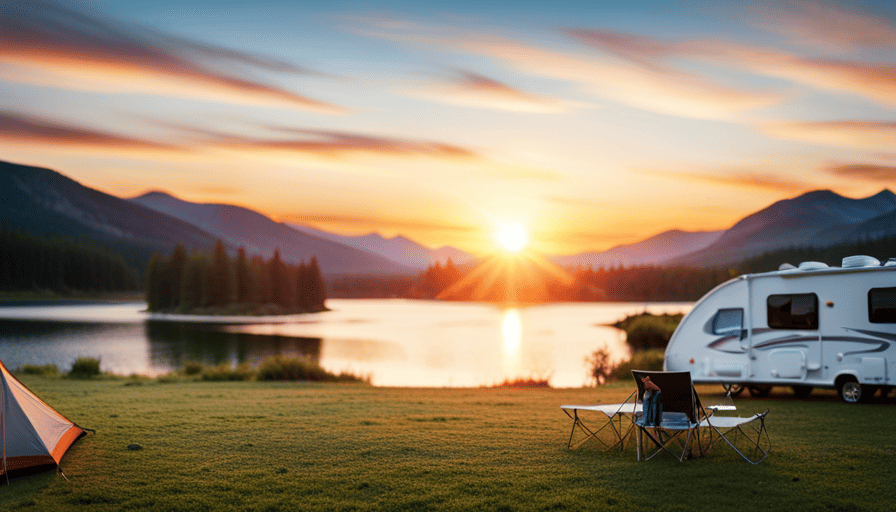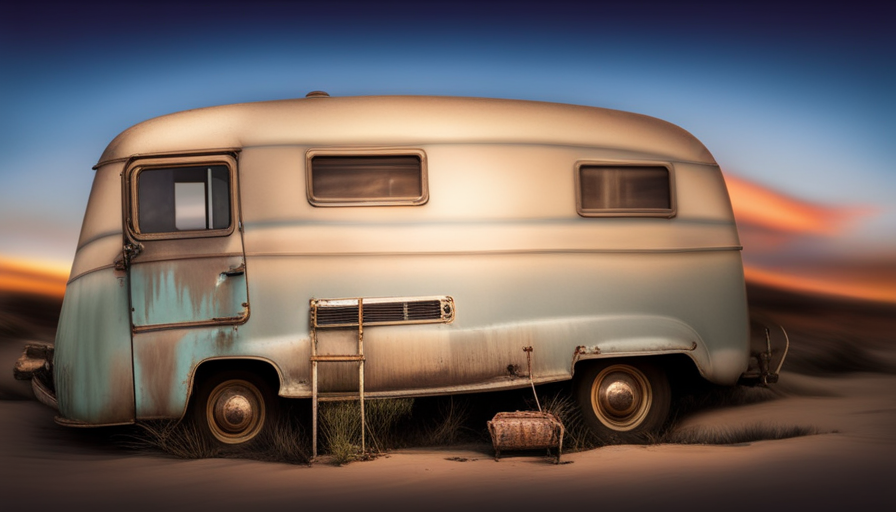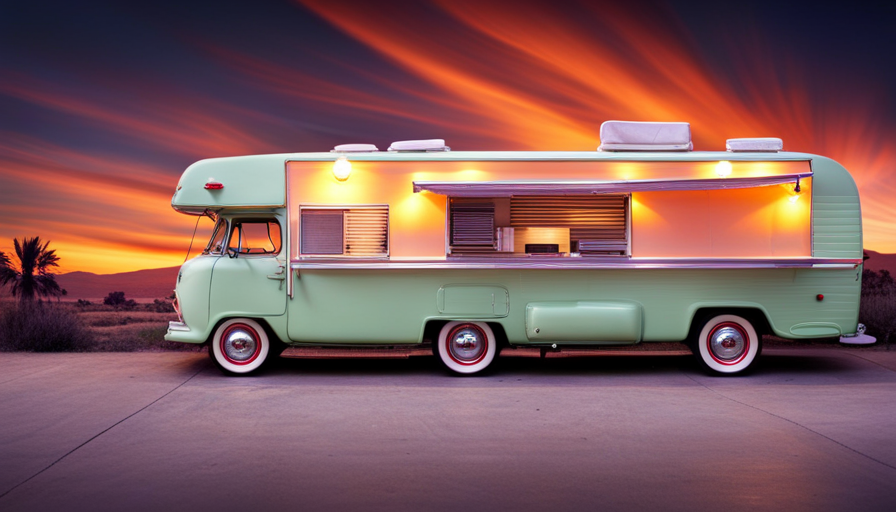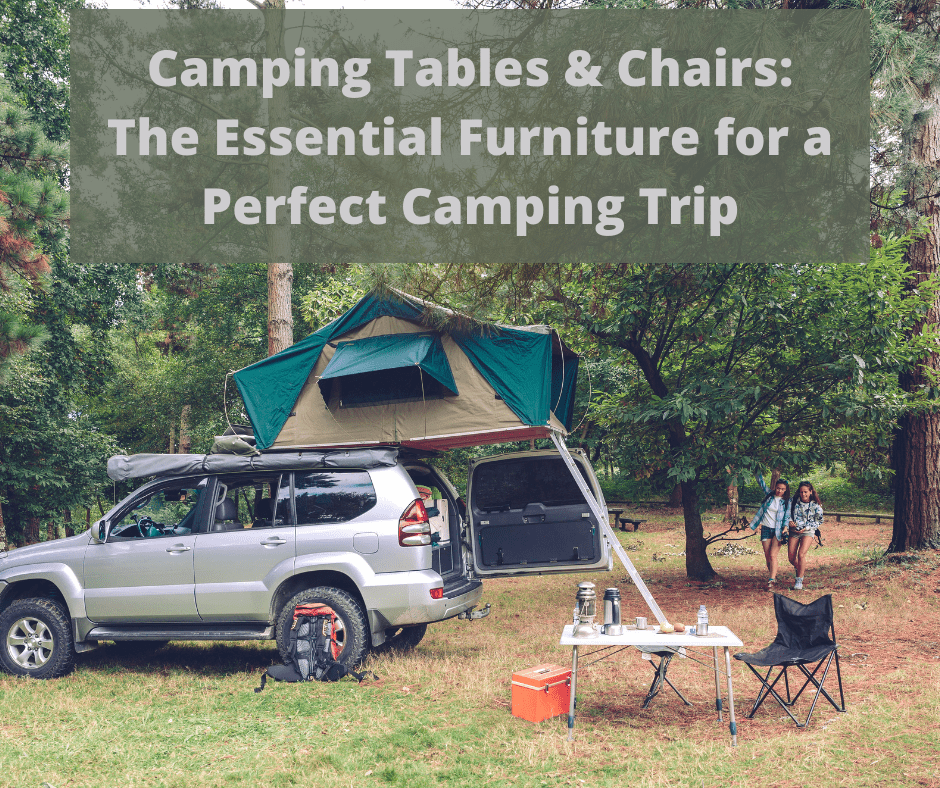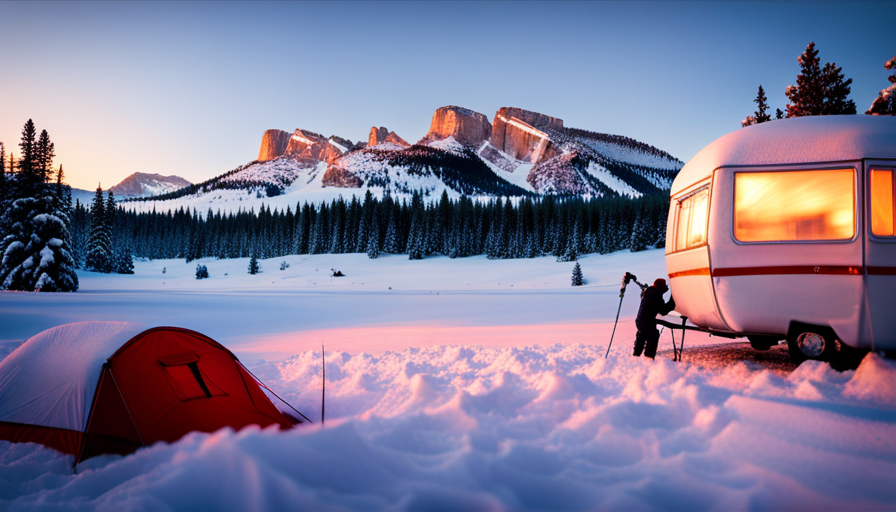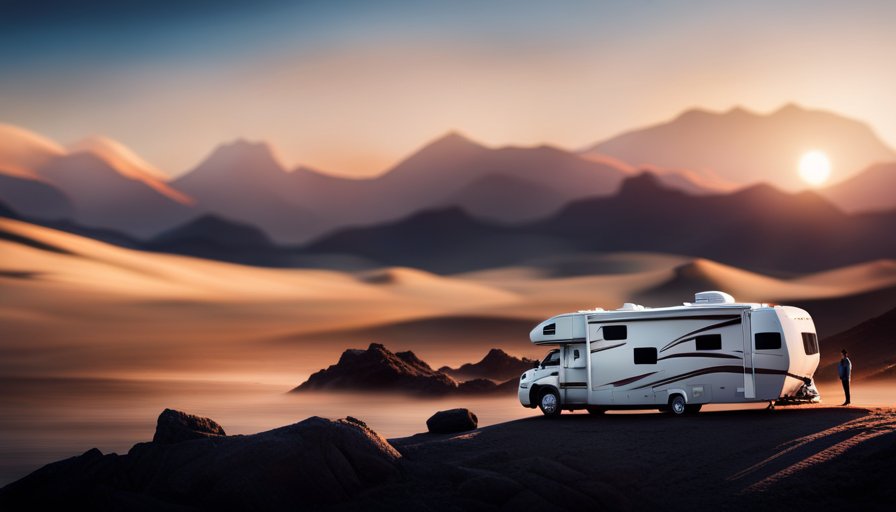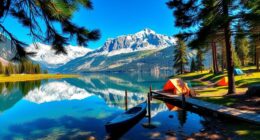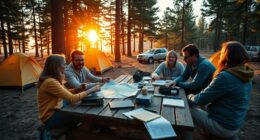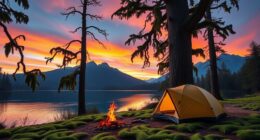Picture this: You’re unwinding by a softly crackling campfire, surrounded by the serene beauty of nature, all while enjoying the comfort of your own camper. It may seem like the perfect dream, but how do you turn this dream into a reality? This is where camper financing comes into play.
Just like a sturdy tent peg holds your tent in place, a camper loan can secure the funds you need to purchase your dream mobile home. In this article, I will guide you through the process of how camper loans work, step by step. From exploring the different types of loans available to understanding interest rates and repayment options, we’ll cover it all.
So, if you’re ready to embark on your camper adventure, let’s dive into the world of camper loans and make that dream a reality.
Key Takeaways
- Different types of camper loans are available, including fixed-rate and adjustable-rate options.
- It is important to determine your budget and loan eligibility by calculating expenses and considering unexpected expenses.
- Researching lenders and comparing options is crucial, taking into account factors such as interest rates, repayment terms, and customer reviews.
- Understanding interest rates and repayment options is essential for making informed decisions and estimating different repayment scenarios using loan calculators.
Types of Camper Loans Available
There are different types of camper loans available, so you can find the perfect one to help you hit the road in style! RV financing options vary, offering flexibility to suit your specific needs.
One common option is a fixed-rate loan, where the interest rate remains the same throughout the entire loan term. This can provide stability in your monthly payments, making it easier to budget.
Another option is an adjustable-rate loan, where the interest rate fluctuates based on market conditions. This type of loan may offer a lower initial rate, but it can increase over time.
Additionally, there are loans specifically designed for full-time RVers, which may have different requirements and terms.
When considering camper loans, it is important to think about loan repayment strategies. You can choose a shorter loan term to pay off the loan faster, but this may result in higher monthly payments. Alternatively, a longer loan term may result in lower monthly payments, but you will end up paying more in interest over time. It’s important to assess your financial situation and determine what works best for you.
Now that you understand the different types of camper loans and loan repayment strategies, it’s time to determine your budget and loan eligibility for purchasing your dream camper.
Determine Your Budget and Loan Eligibility
To determine your budget and eligibility for a loan, you’ll need to crunch the numbers and make sure you’re not biting off more than you can chew. As the old saying goes, "Don’t count your chickens before they hatch."
Start by calculating your expenses and figuring out how much you can afford to spend on a camper. Consider not just the purchase price, but also the cost of insurance, maintenance, and any additional equipment or accessories you may need. It’s important to be realistic and conservative with your estimates, taking into account any potential unexpected expenses that may arise.
Once you have a clear idea of your budget, it’s time to determine the loan terms that work best for you. This includes deciding on the loan amount, the repayment period, and the interest rate. Use online calculators or consult with lenders to get an idea of what your monthly payments would be for different loan scenarios. Keep in mind that a longer repayment period may result in lower monthly payments, but it could also mean paying more in interest over the life of the loan.
Now that you have a better understanding of your budget and loan terms, it’s time to research lenders and compare loan options. This will help you find the best deal and ensure that you’re getting the most favorable terms possible.
Research Lenders and Compare Loan Options
Once you’ve determined your budget and eligibility for a loan, it’s time to dive into researching lenders and comparing different options to find the best deal for your needs.
When researching lenders, it’s important to consider factors such as interest rates, repayment terms, and customer reviews. Start by making a list of potential lenders and visit their websites to gather information about their loan products. Look for lenders that specialize in camper loans as they’ll likely have more knowledge and experience in this area.
Next, compare loan options by requesting quotes from multiple lenders. This’ll give you a clear idea of the interest rates and repayment terms you can expect. Pay close attention to any additional fees or charges that may be associated with the loan.
Additionally, consider reaching out to friends, family, or fellow campers who’ve previously obtained camper loans. They may be able to provide recommendations or share their personal experiences with different lenders.
Once you have gathered all the necessary information and compared your options, you can make an informed decision about which lender and loan option is right for you.
When you’re ready to move forward, the next step is to gather the necessary documents for your loan application.
Gather Necessary Documents for Loan Application
Get ready to dig into your paperwork stash and gather all the essential documents you’ll need for that loan application!
When applying for a camper loan, it’s important to have all the necessary documents in order to streamline the process and increase your chances of approval.
The first document you’ll need is proof of income, such as recent pay stubs or tax returns. This shows the lender that you have a stable source of income and can afford the loan payments.
Next, gather your identification documents, including a valid driver’s license or passport. Lenders need to verify your identity to ensure you are who you say you are.
Additionally, you’ll need to provide proof of insurance for the camper you plan to purchase. This protects both you and the lender in case of any accidents or damages.
Finally, gather any other relevant documents, such as bank statements, proof of residency, and employment verification. These documents help paint a complete picture of your financial situation and increase your credibility as a borrower.
With all your necessary documents in hand, you’re now ready to move on to the next step of applying for a camper loan.
Apply for a Camper Loan
Ready to hit the road and make memories? Start your journey today by applying for a camper loan! Here’s what you need to know about camper loan requirements and the benefits they offer:
-
Simple application process: Applying for a camper loan is straightforward and hassle-free. You’ll need to provide basic information such as your personal details, income, and employment history. Some lenders may also require a down payment, so be prepared to include that as well.
-
Flexible loan terms: Camper loans come with flexible repayment terms, allowing you to choose a duration that suits your financial situation. Whether you prefer a shorter term with higher monthly payments or a longer term with lower payments, there’s a loan option to fit your needs.
-
Competitive interest rates: One of the major advantages of camper loans is the competitive interest rates they offer. With good credit, you can secure a loan with a lower interest rate, saving you money over the life of the loan.
By meeting the camper loan requirements and taking advantage of the benefits they offer, you’ll be one step closer to hitting the road in your dream camper. Now, let’s delve into the next section and explore the loan approval process and terms.
Loan Approval and Terms
Now that you’re on the road to securing your dream camper, let’s dive into the exciting world of loan approval and the terms that will make your journey even more enjoyable.
The loan approval process for camper loans involves several steps. First, you’ll need to submit an application to the lender. This application will include information about your credit history, income, and the camper you intend to purchase. The lender will then review your application and assess your creditworthiness. Factors such as your credit score, debt-to-income ratio, and employment history will be taken into consideration.
Once your application is approved, the lender will provide you with the loan terms. These terms will include the interest rate, loan amount, repayment period, and any additional fees or charges. It’s important to carefully review these terms to ensure they align with your budget and financial goals.
Factors affecting loan terms may include your credit score, income level, and the loan amount. Understanding interest rates and repayment options will be the next step in your camper loan journey.
Understand Interest Rates and Repayment Options
Upon understanding the interest rates and repayment options, I can make informed decisions that align with my financial goals and ensure a smooth journey towards owning my dream camper. When it comes to loan terms, it is crucial to carefully review the length of the loan and any potential penalties for early repayment. This will help me determine the most suitable repayment plan for my needs.
To calculate interest, borrowers can use a simple interest formula. This involves multiplying the loan amount by the interest rate and the length of the loan in years. It is important to note that the interest rate may vary depending on factors such as credit history and the lender’s policies. By understanding the calculations involved, I can estimate the total amount I will pay over the life of the loan and assess if it fits within my budget.
Repayment options vary, but the most common one is monthly payments. This involves dividing the total loan amount, including interest, by the number of months in the loan term. This ensures a consistent payment schedule that is easier to manage. Other options may include bi-weekly or quarterly payments, depending on the lender’s policies.
By comprehending interest rates and repayment options, I can make an informed decision about my camper loan. In the next section, I will delve into the process of making monthly loan payments.
Make Monthly Loan Payments
Get ready to embark on a monthly payment journey that will keep your financial ship sailing smoothly towards owning your dream camper. When it comes to making monthly loan payments, it’s important to explore different loan repayment options to find the one that suits your financial situation.
Some lenders offer flexible repayment plans, allowing you to choose between fixed monthly payments or variable payments based on your income. This flexibility can be a great advantage if you anticipate changes in your financial circumstances.
Understanding the impact of interest rates is crucial when making monthly loan payments. The interest rate determines the additional amount you’ll be paying on top of the principal loan amount. Higher interest rates mean higher monthly payments and a longer repayment period. On the other hand, lower interest rates can help reduce your monthly payments and shorten the overall loan term.
To make the most informed decision, consider using loan calculators to estimate different repayment scenarios and determine the best option for you. Additionally, discuss your options with your lender to get a clear understanding of the terms and conditions.
Now that you understand how to make your monthly loan payments, let’s dive into the next section about insurance requirements for camper loans.
Insurance Requirements for Camper Loans
Ready to protect your investment? Let’s talk about the insurance requirements you’ll need for your dream camper.
When it comes to camper loans, insurance coverage is a must. Most lenders will require you to have comprehensive and collision coverage to protect both you and them in case of an accident or damage. These coverages will pay for repairs to your camper if it’s damaged in an accident, stolen, or vandalized. They will also cover medical expenses for you and your passengers if you’re injured in an accident.
In addition to comprehensive and collision coverage, you may also be required to have liability coverage. This coverage will protect you if you cause damage to someone else’s property or injure someone in an accident. It’s important to note that the specific insurance requirements can vary depending on the lender, so it’s important to check with them to make sure you have the appropriate coverage.
To meet the loan requirements, you’ll need to provide proof of insurance to your lender. This can usually be done by providing them with a copy of your insurance policy or a certificate of insurance. It’s important to keep your insurance coverage active throughout the duration of your loan to ensure that you’re protected.
Now that you understand the insurance requirements for camper loans, let’s move on to the next section and talk about how to enjoy your camper adventure!
Enjoy Your Camper Adventure!
So, you’re all set to embark on your camper adventure and make unforgettable memories on the road! Did you know that 85% of campers say that traveling in a camper allows them to connect more with nature?
Now that you have your camper and insurance requirements in place, it’s time to start planning your trip and exploring the best destinations.
When it comes to planning your camper adventure, there are a few tips to keep in mind. First, create a travel itinerary with a list of the places you want to visit and the activities you want to do. This will help you stay organized and make the most of your time on the road.
Next, research campgrounds and RV parks along your route to ensure you have a place to stay each night. It’s also a good idea to make reservations in advance, especially during peak travel seasons.
As for the best destinations, the options are endless. If you’re a nature lover, consider visiting national parks such as Yellowstone, Yosemite, or the Great Smoky Mountains. These parks offer breathtaking landscapes and opportunities for hiking, wildlife spotting, and camping.
If you prefer coastal views, destinations like the Pacific Coast Highway in California or the Outer Banks in North Carolina are great choices. And for those seeking city adventures, places like New York City, Los Angeles, or Chicago offer a mix of culture, entertainment, and camping options nearby.
So, get ready to hit the road and enjoy your camper adventure! Remember to plan ahead, explore the best destinations, and most importantly, have fun connecting with nature along the way. Happy travels!
Frequently Asked Questions
Can I use a camper loan to purchase a used camper?
Yes, you can use a camper loan to purchase a used camper. Financing a used camper offers several advantages.
Firstly, it allows you to spread the cost of the camper over a period of time, making it more affordable. Additionally, you can often secure lower interest rates on used camper loans compared to other types of loans.
Finally, buying a used camper with a loan provides you with the opportunity to enjoy the benefits of owning a camper without paying the full amount upfront.
What is the average interest rate for camper loans?
The average interest rate for camper loans depends on several factors. These factors include your credit score, the loan term, and the lender you choose.
On average, the interest rates for camper loans range from 4% to 10%. A higher credit score generally leads to a lower interest rate, while a longer loan term can result in a higher rate.
It’s important to shop around and compare rates from different lenders to find the best deal for your camper loan.
Can I include the cost of insurance in my camper loan?
Yes, you can include the cost of insurance in your camper loan. This is a beneficial option as it allows you to spread out the expense over the loan term.
Additionally, having insurance coverage for your camper is important as it protects you financially in case of accidents, damages, or theft. It’s also essential to consider the cost of maintenance when budgeting for your camper loan, as regular servicing and repairs are necessary to keep your camper in good condition.
How long does the loan approval process typically take?
Getting approved for a camper loan can take varying amounts of time, depending on several factors. To speed up the process, there are a few things you can do.
First, make sure you have all the necessary documents ready, such as proof of income and identification. Additionally, having a good credit score and a stable employment history can also help expedite the approval process.
On the other hand, factors that can delay loan approval include incomplete or inaccurate information on your application, a low credit score, or a history of late payments.
Are there any penalties for paying off my camper loan early?
Yes, there can be penalties for paying off a camper loan early. These penalties vary depending on the lender and the terms of the loan agreement.
However, there are also advantages to paying off your loan early. By doing so, you can save money on interest payments and potentially improve your credit score.
It’s important to carefully review your loan agreement and discuss any potential penalties with your lender before deciding to pay off your camper loan early.
What Information Do I Need to Include in a Bill of Sale for a Camper When Applying for a Camper Loan?
When applying for a camper loan, it’s important to include specific information in the writing camper bill of sale. This should include the seller and buyer’s names and addresses, the camper’s VIN number, the purchase price, and the date of sale. Additionally, both parties should sign the bill of sale.
Conclusion
So there you have it, folks! Now you know all about how camper loans work. Isn’t it just fascinating? I mean, who wouldn’t want to dive headfirst into the world of interest rates and monthly payments? It’s a thrill like no other!
But hey, if you’re planning on embarking on a camper adventure, understanding the ins and outs of these loans is crucial. So go ahead, take the leap, and enjoy every moment of your camper adventure. Just make sure to keep those monthly payments in check!

